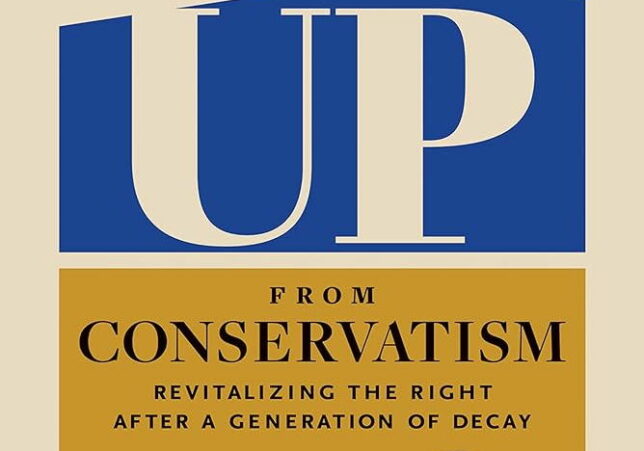Special Report
On the Question of Right Fights: National Conservatism at Arms


On the Question of Right Fights (full series)
Factions on the Right | Dueling Manifestos
National Conservatism at Arms | Postliberals for American Liberalism
“Grill Dad Republican”
National Conservatism at Arms: Up from Conservatism
For their part, nine signers of the National Conservatism statement and 10 allies of their movement put forward essays compiled by National Conservatism statement signer Arthur Milikh of the Claremont Institute, a think tank that is self-consciously aligned with the New Right tendency, denouncing the “generation of decay” in right-of-center politics and promoting a new way forward. Keeping with the spirit of intensely personal and often tendentious invective in right-fighting, the tone of denunciation, common throughout National Conservative and broader New Right writing, pervades the collection.
Not all the essays see invective overcome wisdom. Richard Hanania (himself a controversial figure for his past writings on race and contemporary support for abortion and euthanasia) offers plausible strategies for conservative institutions and policymakers to reduce the power and influence of left-ideological institutions, properly drawing the distinction between redeemable (lefty-of-convenience-or-fear) institutions like business and irredeemable (lefty-of-conviction) institutions like organized labor.
Aaron Renn and Joshua Mitchell offer caution for the Integralist-Postliberal faction, which relies on Roman Catholicism and claims to derive from historical Catholic teaching. They suggest that conservative intellectuals are disproportionately Catholic because Catholics have a longstanding overrepresentation in the high halls of conservatism (one might note that since the original neoconservatives of the mid-20th century Jews have as well, causing further problems for Integralism), but note that the backbone of the conservative voting base is low-church Protestant, indicating that a sectarian-Catholic position as a defining right-wing force has a likely insurmountable climb. (One might also note the difference between Catholic profession and fully committed Catholic practice, even among conservative-voting Catholics, as another indication.)
But other essays show the weaknesses in New Right approaches. Milikh and his Claremont colleague Scott Yenor propose “How to destroy and reconquer” education. That a project of pushback (in extremis, “reconquest”) is necessary is not disputed among the factions. To pick an example, Commentary, the generally Trump-skeptical Jewish conservative magazine, titled a podcast episode on the Claudine Gay plagiarism scandal “Should Harvard Be Burned Down?”
But the New Right struggles to be, frankly, normal. (This affliction is common to ideologues; just read any left-wing group’s diversity, equity, and inclusion statement and luxuriate in overcomplicated jargon that would give the George Orwell who wrote “Politics and the English Language” conniptions.) First, there is an unusual desire to attack successful mainstream conservative efforts. Legalizing homeschooling nationwide and beginning a long-overdue expansion of school choice? Not enough, for the perfidious RINOs who support those policies have failed to achieve all right-wing aims immediately and have avoided frontal-assault combat. Never mind that the history of frontal assaults is littered with predictable failures, among them the Confederate charge on the third day at Gettysburg.
And that seems to be where the Milikh-Yenor approach would lead, in part thanks to the normality problem. In what is to be fair a speculative exercise in hypothetical ways to change school curriculums, the pair propose that “every male student could learn to skin an animal and every female to milk a cow.” Why? It’s unclear. Milikh and Yenor are not proposing a complete deindustrialization of the country; they propose the much more enticing “adopt[ion] of a policy designed to create a leading corps of STEM [science, technology, engineering, and mathematics] experts.” How 19th-century farm labor is supposed to bring this about is unclear. This perhaps indicates un-ripened thinking.
The urge to fratricidal combat that afflicts the New Right leads the essayists down other dead-end corridors. The New Right’s ascendancy, to the extent it exists, is based on the failures of the previous leadership of the conservative movement, especially in the second term of President George W. Bush. For this, the recent successes of the legal conservative movement defined by Leonard Leo and the Federalist Society, especially the overturn of Roe v. Wade in Dobbs v. Jackson, are a decidedly bad fact.
The rise of the legal conservative movement demonstrates not only capitalization on Republican election wins, but affirmative success in moving the party to the right. Supreme Court justices nominated by Richard Nixon, Gerald Ford, and Ronald Reagan voted 6-2 to establish or uphold the Roe-Casey “abortion rights” regime. Those nominated by the Bushes and Donald Trump after the rise of the legal conservative movement voted 5-2 to overturn it.
But to Claremont’s Jesse Merriam, the legal conservative movement failed. Why? Because it cared too much about defending ethnic-minority parties to lawsuits against governments and failed to expound “a moral system that challenges diversity and discrimination as the axes around which our constitutional order revolves.”
But what if, rather than engaging in submission to the Left in the name of ideological perfidy, legal conservatives were engaged in a prudential and moral calculation? Merriam demands a recommitment to total “freedom of association,” including the power to “determine whom we worship with, whom we speak to, and whom we have as neighbors” in opposition to the prevailing civil rights regime, which is hard to read as other than a call to permit presently forbidden forms of private discrimination even if it is not his intention.
There is an alternative, even for the National Conservative. One could argue for applying the civil rights laws in a racially neutral manner to all—no racial discrimination, and no affirmative action either. This is essentially the position of former Claremont fellow, Manhattan Institute activist, and signer of the National Conservatism statement Christopher Rufo, who engages in bold combat against the left-wing critical race theory and diversity, equity, and inclusion movements. As Rufo has written:
Despite the success of critical race theory in prestige institutions, American voters still prefer individualism, colorblindness, and equal protection under the law. Even voters in deep-blue California have rejected affirmative-action policies that would judge individuals according to race rather than merit. The challenge is to turn this public preference into public action. Critical race theory has spread through our institutions, despite strong public opposition.
What to do about civil rights isn’t the only question of prudence that the Up from Conservatism essayists turn into one of supposed Establishment perfidy. David Goldman asserts that “much of the conservative establishment” would support “legalizing all recreational drugs” to boost the economy, which is somewhere between wrong and an outright lie. True libertarians at the Cato Institute or Reason magazine might, but they would not call themselves conservative. And while some on the right propose legalizing marijuana, the experiences of legalization jurisdictions have made even pro-legalization conservatives more skeptical of extending the experiment.
In the next installment, the Postliberal faction seeks a return to the post–World War II political economy.



